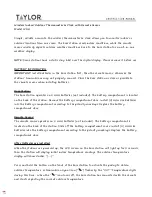
IMPORTANT SAFEGUARDS
WHEN USING ELECTRICAL
APPLIANCES, THE FOLLOWING BASIC
SAFETY PRECAUTIONS SHOULD BE
FOLLOWED:
1.
READ AND FOLLOW ALL
INSTRUCTIONS CAREFULLY.
2. WARNING — To reduce the risk of
fire and electrical shock:
DO NOT
USE THIS CONTROL FOR
ANY COMBINATION OF HEATERS
EXCEEDING 500 WATTS.
3. Wires or cables to the control
should be arranged so that their
weight
does not pull on the control.
4. Do not immerse the control in water
for cleaning.
5. Install all heater plugs
prior to
plugging control into a wall outlet.
6. Do not allow heavy objects to rest
on the control or heater cords.
7. This control is NOT designed for use
inside
the terrarium.
8. This control is NOT designed to
control the temperature of a rock
heater inside the terrarium. (Use
Zoo Med’s ReptiTemp Rheostat
instead.)
8. To reduce the risk of electric shock,
this equipment has a polarized
plug (one blade is wider than the
other). This plug will fit in a polar-
ized outlet only one way. If the plug
does not fit fully in the outlet,
reverse the plug. If it still does not
fit, contact a qualified electrician to
install the proper outlet. Do not
change the plug in any way.
SAVE THESE INSTRUCTIONS
WARNING — FIRE OR ELECTRICAL
SHOCK MAY RESULT FROM MISUSE.
MOUNTING INSTRUCTIONS
1. Insert heater plugs into the ReptiTemp
®
Thermostat’s plug receptacles
before
attaching the ReptiTemp
®
to the glass
side of your terrarium.
2. Mounting thermostat to terrarium:
Peel the release paper from the back
side of the thermostat then
press
thermostat firmly
against side or rear
glass terrarium panel. Hold
thermostat in position for 1-2
minutes so it will adhere properly.
Note:
Your thermostat has a Velcro
®
attachment which will allow you to
remove the thermostat for adjustment.
3. Plug control cord into an electrical
power source. (Use of an extension
cord is not recommended.)
4. Remote Sensor Probe: Place the end
of the 6 ft. sensor wire inside the
enclosure. Wherever the probe is
placed is where the 500R will be
sensing the temperature.
5. Set the control knob at the middle
setting initially. The thermostat’s
indicator light should be on, with
the power going to the heating
devices. If not, turn the knob
clockwise (higher) slightly past the
point at which the indicator light
comes on. When the light goes off,
this indicates the terrarium
temperature has reached the
thermostat’s “set point.” If you desire
higher or lower temperatures then
simply turn the thermostat control
knob either up or down until the
desired temperature has been
reached and set.
Remember:
the
indicator light will cycle on and off
to show that the thermostat is
working and is at a
“set”
temperature. (Much like the
thermostat adjustment on an
aquarium heater.)
6. When you are satisfied with the
temperature achieved, slip the
control safety cover
into place so
that the long tabs on the inside of
the cover fit into the slots along the
mid side of the controller housing.
7.
VERY IMPORTANT:
“Wattage versus
overall ambient air temperature.”
When purchasing a reptile heating
device make sure it has the
ability
(i.e; wattage) to
reach
the air
temperature you desire inside your
terrarium. Example: A 150 watt
ceramic heat emitter may be able to
warm a 30-gallon terrarium to 80°F
in a 65-70°F house. However, a 60
watt ceramic heat emitter or spot
bulb on a 30 gallon terrarium might
not be able to reach 80°F in a 65-
70° house!
Remember:
When controlling
heating devices with the ReptiTemp
®
Thermostat make sure you have
enough
watts of heat
to bring your
terrarium up to the desired
temperature level.
Applications/Advantages:
ReptiTemp
®
500R
(Remote Sensor Thermostat)
Besides your normal glass terrarium,
the remote sensor wire feature on the
above thermostat is also ideal in the
following applications:
Acrylic Terrariums:
The ReptiTemp
®
500R
works perfectly in all acrylic terrariums
10 gallons or larger.
IguanAriums
®
and Wire Terrariums:
The remote sensor wire can be put at
any level
of the cage for precise
temperature control.
Very large glass terrariums:
100 gallons
and up whereas the sensor wire will
give precise control in the
warm basking
area
thus allowing a normal
temperature gradient in the rest of the
terrarium.
Day/Night Cycle Feature
Many Reptile Thermostats (currently on
the market) have built in day/night
cycle features but cost you $300.00 or
more!! Zoo Med’s ReptiTemp
®
500R
can simulate a natural day/night
temperature cycle with the simple
addition of an inexpensive timer. Here’s
how it works — say you are heating a
30 gallon terrarium with one 100 watt
ceramic heat emitter and one RH-5
(ReptiTherm
®
Under Tank Heater). Plug
the higher 100 watt heating device into
the thermostat and plug the UTH
directly into the wall. Next plug the
thermostat into the timer (make sure the
timer is rated for at least 100 watts),
and finally plug the timer into the wall.
Now as per previous instructions
establish your “daytime” temperature
set point (with timer in the “on”
position). Once a stable set point is
established, set the
timer
so it goes
on
at 6:00 A.M. and off at 7:00 P.M.
Since the “daytime” temperature set
point is maintained using both the
ceramic heat emitter and the UTH,
during the “night cycle” the
temperature will drop due to the shut
off of the Ceramic Heat Emitter and
Thermostat by the timer.




















